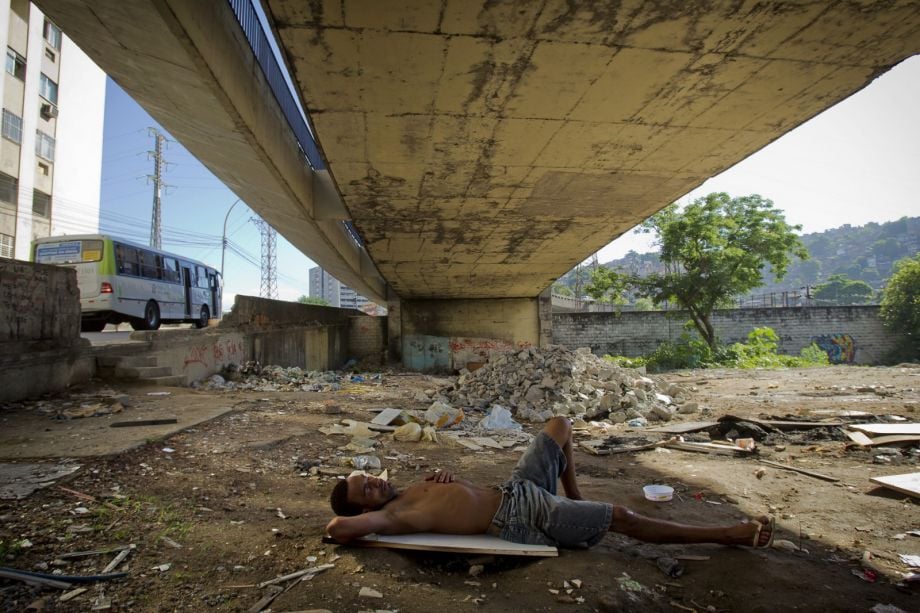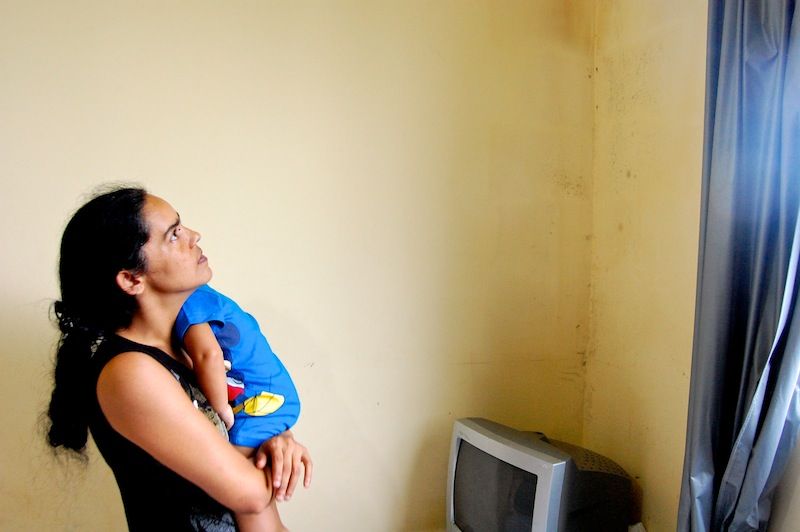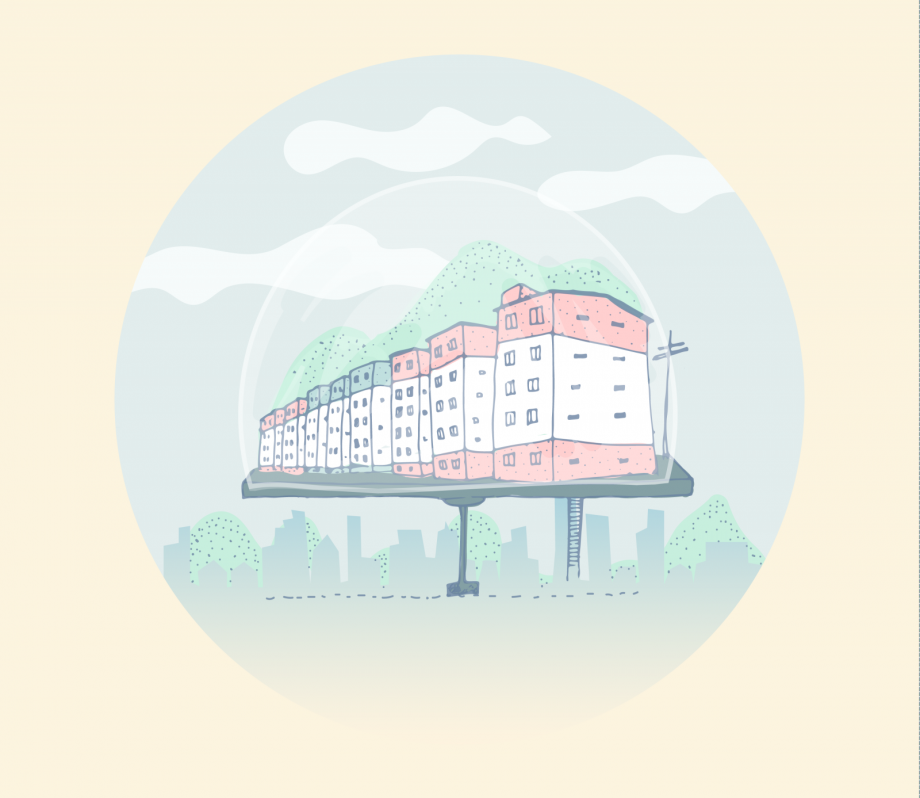Are You A Vanguard? Applications Now Open
This is your first of three free stories this month. Become a free or sustaining member to read unlimited articles, webinars and ebooks.
Become A MemberYou are probably not welcome in the Oiti apartment complex in Campo Grande, a neighborhood in Rio de Janeiro’s Far West Zone. As you approach, the gatekeeper eyes you with suspicion — you can only get past the iron entrance gate if you know someone who lives there. Inside, a heavy silence permeates the halls. Even the garlickly smell of beans cooking, so prevalent in many of Rio’s residential buildings, is more muffled here, and residents greet strangers at their doors with skeptical stares.
Patrícia dos Santos, who moved here three years ago, thinks daily of her old home in a favela called Vila Recreio II. In Vila Recreio II, about 10 miles from here, more than 200 families raised children, built houses and worked toward better lives together. The weekend street barbecues that cultivated her old favela’s sense of community never occur here at Campo Grande. Here, public life is scarce and fraught with a subtle tension.
Patrícia’s Campo Grande apartment, brand new but already corroding, is part of a hastily built public housing complex that holds ominous signs for Rio’s future. In 2011, the city government told Patrícia and her husband, Luciano, that a highway would soon be built through the spot where Vila Recreio II stood. Like their neighbors, they would be evicted, and they were offered a choice: They could sell their house to the city for demolition, or take a public housing unit as compensation. Faced with a paltry offer of $4,500 for their home, the dos Santoses moved with 10 of their neighbors into the Oiti. Others from Vila Recreio II were scattered across several other Campo Grande housing projects. They’re among the over 20,000 families in Rio de Janeiro who lost their homes in the run-up to this month’s World Cup and the 2016 Olympics.
This is becoming a familiar story. We heard it two years ago in Sochi, four years ago in Cape Town, six years ago in Beijing — the pre-sporting event mega-projects that cause mega-displacement. Rio has certainly witnessed a boom in such projects as it prepares for its football matches. The city is awash in eye-catching upgrades and ribbon-cutter photo-ops, from a new bus rapid transit system to an IBM-designed “command center.”

A homeless man sleeps where houses were demolished in a Rio de Janeiro favela. Photo credit: AP/Victor R. Caivano
But the mass resettlements that have accompanied these projects, while affecting fewer people than Beijing’s did in 2008, are just one part of a much broader nationwide public housing experiment that’s transforming Brazil. A decade ago, with progressive housing advocates in the federal government, Brazil was pioneering a new, forward-thinking attitude toward housing for the poor. National policy had been written to respect favelas as valid neighborhoods of commerce and culture. It was the kind of urban policy many urbanists dream of, in fact, and one that let people like Patrícia dos Santos work their way toward better housing and financial stability.
Those days are now over. The city is in the midst of a massive reorganization of its housing schema propelled by the world’s two biggest sporting events. Pushed by a construction-industry-backed president who saw real estate as a way to stimulate Brazil’s economy, the country has made a hard turn away from supporting poor, mixed-use neighborhoods, and is instead demolishing those neighborhoods and placing the occupants in public housing complexes like the Oiti. If official statements are any indication, it’s a trend that will likely continue even after the athletes pack up and leave town, prompting some development experts to wonder whether Rio’s sporting spectaculars will leave behind vast new ghettos of poverty in their wakes.
Patrícia dos Santos lives narrow days in the Oiti. She interacts with few others and no longer lets her three children play outside after she saw armed young men holding court in the driveway. When in March, Luciano went down to their new local police station to register a threat from a neighbor, he was jailed for failing to complete community service required after a 2010 misdemeanor. He never received notice that he had community service to perform, because although he had registered his change of address, the notification was mailed to the site of their old favela, which had already been demolished. (Where that favela once stood, there should now be a highway, but instead, tall grasses rustle in the wind, undisturbed by the new road, which ended up being built 300 feet away.)
The strangers they now live among mocked Patrícia after Luciano’s arrest, so she only feels comfortable socializing with the handful of other Oiti families from Vila Recreio II. She speaks to her lawyer on the telephone, for three months now unable to visit her husband or even speak to him due to an arcane protocol for contact with prisoners. Her former two-bus, one-hour commute to her workplace in the neighborhood of Barra de Tijuca changed to four hours and four different bus rides each way — one of these rides via the new BRT line, meant to streamline traffic (and for which Patricia lost her house.) The commute quickly became unworkable for the mother of two, and so Patrícia, like many of her neighbors, was unable to keep her job. All of their lives today are marked, in various ways, by the distance.
The dos Santoses’ problems are emblematic of a housing dynamic in Rio that has grown more problematic over time. Geographically, Rio developed as a spatial melting pot. For decades, affordable housing was plentiful — people simply built it themselves, peppering neighborhoods both wealthy and poor with simple brick homes. But over the course of the 20th century, for varying official justifications, favela residents were resettled into public housing blocks. When the capital of Brazil moved from Rio to Brasilia in 1960, Rio’s downtown, a transit-rich employment center, was left littered with empty buildings.
This problem should have been fixed by Brazil’s 1988 constitution, which created municipal and national forums for architects, planners, social movements and builders to propose and debate urban policy. In 2005, these forums created a federal fund for “social interest” housing that would reserve a billion reais ($44.7 million) per year — not for monumental public-housing blocks on the urban fringe, but for favela upgrades, loans on construction materials, adaptive reuse and technical support for low-income cooperatives. FHNIS (the fund’s Portuguese acronym) was celebrated nationally and internationally for helping Brazilians build homes in the places and styles that best fit their needs.

Patrícia dos Santos in her Campo Grande apartment. Photo credit: Catherine Osborn
The dos Santoses are exactly the type of family that benefitted from this arrangement. Patrícia, 35, and Luciano, 39, moved to Rio de Janeiro from rural Bahia as newlyweds in search of a better life. They heard from a friend about a group of people building homes together in the city’s western neighborhood of Recreio. For seven years they lived in their wooden house in the favela of Vila Recreio II, she working as a cleaning lady, he at a pastry stand.
Though they wouldn’t lose this home for seven more years, their fate was effectively sealed in 2009, when President Lula da Silva announced an old-school federal public-housing program that pumped more money into housing than had been invested since the 1960s, but largely ignored the new constitution’s frameworks for adaptive reuse, co-ops and favela upgrading. The scheme, called Minha Casa Minha Vida (MCMV, or My House, My Life), was based on a proposal from Rio’s civil construction sector, and pledged 34 billion reais ($15 billion) to construct a million housing units and sell them to low-income Brazilians at subsidized mortgages.
As da Silva’s chief of staff, Dilma Rousseff, announced the program at a televised press conference, a representative of the national civil construction interest group grinned widely at her side. The building boom was promoted, in part, as a way to boost Brazil’s economy out of recession. But the country’s urban thinkers were skeptical. This was a radical departure from the policy they designed.
Almost as soon as they were built, the MCMV complexes in Rio became a magnet for criticism. In 2010, Raquel Rolnik, then the United Nations Special Reporter on Adequate Housing, gave a speech inside the Rio mayor’s office warning against the new housing’s segregating effects and lack of quality control. City housing department official Antonio Veríssimo said that concentrating public housing in the infrastructure-poor West Zone would form “further ghettos of poverty.” Rio newspapers began reporting stories of MCMV apartments flooding and cracking, and their residents failing to find work.
At the local level, the Rio de Janeiro government took the new policy and made it even worse. They modified the national standards for the new public housing to allow apartments with smaller surface area per unit, a greater number of floors to be built without an elevator, looser requirements for proper drainage and fewer recreational spaces. Within two years, more than 57,000 units were licensed, 67 percent of which lay in the Far West Zone. (Rio’s five zoning designations are North, South, Center, West and Far West. In 2008, the city calculated that the Far West Zone contained 7.5 percent of Rio’s formal jobs. The Center, where 1.2 percent of Rio’s public housing was built over this time, contained 36.8 percent of the city’s jobs.)
The projects in Rio’s Far West Zone are up to 35 miles away from the center of the city: rows of nondescript apartment blocks, encircled by driveways and fences, rising from farmland and abandoned military sites. It’s out here, far from the dense dynamics of the city center, that not only buildings are beginning to break down, but the social order as well.
Patrícia reads the paper to find out about other MCMV projects. In April she was concerned by the news that apartments in another development in Campo Grande were taken over by a milícia, an extortion gang that charges residents extra “taxes” on utilities and transportation, and in this case, drove residents out of their apartments in order to sell them for personal profit. In 2011, a milícia was expelled from the same apartment complex, and 10 others, for the same offense.
Milícias in Rio de Janeiro punish those under their jurisdiction for speaking to the press and sometimes work closely with local police officers, so it’s hard to track them precisely. But an extensive 2011 study found them concentrated in the city’s West Zone, home to thousands of new Minha Casa Minha Vida apartments. Reflecting on organized crime in MCMV, Federal University of Rio de Janeiro Professor Adauto Cardoso says, “I am not going to say that we should expect public housing not to include things that are present in the rest of the city. But closed, isolated spaces facilitate control. I imagine a much harder time for criminals to try to control smaller-scale, mixed-use communities that are openly integrated into the rest of the city.”
Cardoso looks to Chile, one of MCMV’s models, to imagine what Rio’s projects might look like in 20 years. Between 1980 and 2000, the Chilean government embarked on a public-housing boom similar to the one now occurring in Brazil, awarding contracts for more than 200,000 subsidized units to be built for low-income residents on the outskirts of Santiago.
It was a disaster. In 2005, a team of researchers classified many of these units as “abandoned by state and social assistance programs” and “functionally obsolete.” They noted frightening conditions inside, including high levels of social conflict, difficulties for residents to participate in governance, rapid physical deterioration, stigmatization and authoritarian rule. In 2012, the Chilean government threw in the towel and began demolishing more than 57,000 units, footing the bill for rent stipends until residents could be rehoused in better locations.
Rio is the most dramatic case – but not the only one – of how MCMV has fostered “the peripheralization of poverty.”
There are already signs that Chile’s troubles may be coming to Brazil. In March 2013, for the first time in Rio de Janeiro, cracked and unaligned walls forced the government to demolish a group of Minha Casa Minha Vida apartments before the new owners could even arrive. Amid the spate of bad press, last year Rio Mayor Eduardo Paes issued a decree banning further MCMV construction in the Far West Zone. The need for this reform has international relevance. Rolnik reported to the UN General Assembly in August 2013 that around the world, there are fatal flaws in public housing finance policies like MCMV’s that “focus solely on access to a roof while failing to effectively and comprehensively address… access to infrastructure and services, habitability, cultural adequacy and security of tenure.”
Some MCMV residents may not even be able to stay in their homes long enough to see them deteriorate, according to Cardoso, because of higher-than-expected utility bills, condominium fees and “taxes” from organized crime groups. A 2012 report by the magazine Veja found that 20 percent of the lowest-income MCMV residents were behind on their mortgage payments, four percent higher than American homeowners’ late-payment rate in the run up to the U.S. financial crisis.
In Brazil, lowest-income residents do not appear to be the biggest beneficiaries of the new MCMV housing. Many cities have failed to reach the target of 40 percent of units for the poorest, who make up 90 percent of the country’s housing deficit. In the first two years of MCMV construction in Rio, 80 percent of housing for the poorest is in the Far West Zone, which makes Rio the most dramatic case — but not the only one — of how MCMV has fostered “the peripheralization of poverty.”
Yet the Brazilian government stands by the program. Last year it published a poll that said nationally, the average satisfaction of new MCMV residents with their homes was an eight out of 10. The government and real estate sector have worked hard to promote the allure of private home ownership through MCMV, and are quick to characterize other forms of housing as precarious at best.
“What makes a city a city?” asks Federal University of Rio de Janeiro Professor Orlando Santos Jr., who has served for years in the local and federal urban-planning forums. “It is a place that contains people who are different from you. It is interacting with and creating something out of diversity.” Santos says that in addition to denying new residents important rights and resources, the segregating nature of affordable-housing construction in Rio is destroying the nature of the city itself.
After years of underfunding for the recommendations of Brazil’s urban policy forums, public participation in crafting housing policy has taken a more aggressive shape in the last year or so, both through the courts and on the streets. Signs with the logos “My House, My Debt” and “My House, My Milícia” dot Rio’s street protests still. In particular, people have petitioned the federal bank to fund a small, red-tape-tangled co-op program within MCMV with the same ease that it has funded the private apartments. The federal government pledged to expand this program earlier this month, only after the São Paulo Homeless Workers’ movement sent 20,000 people to the streets and threatened to block the opening of the World Cup. In Rio it has taken unrelenting social mobilization and several lawsuits filed by the public defender to make sure the first few new MCMV units were built adjacent to the favelas from which people were removed.
For those who have already been moved to Rio’s more isolated public housing, interaction with the outside world is thin. A rare civil society initiative to address this came in 2012, when a hip-hop collective organized a show at a MCMV project in Bangu, near Vila Kennedy. One organizer, domestic worker Charlene Santos, says that in honor of Brazil’s Black Conscience Day, the group aimed to “bring culture to a place where there was none.”

“Rio is a great cultural accelerator, but culture isn’t allowed to flourish in all parts of the city,” Santos says. “Because we knew someone in one particular apartment, we were allowed to plan something. We talked with young people there about the fact that there is a kind of culture that makes a critique, and that carries lots of information. It tells stories of how people are living and spending their days and asks, who is winning and who is losing with the project of today’s society?”
Santos’s group has wanted to organize another workshop for more than a year, but has been unable to access the MCMV developments. “Those apartments are not open spaces that you can enter freely,” she says.
In Rio, government officials are responding to the public criticism by focusing on a few new public housing developments that they hope will put a better face on MCMV. Money has been directed toward adding more units on the site of an abandoned power plant in Triagem, slightly north of Rio’s center, where the government used a well-established legal framework to take control of the abandoned public facility. Called Bairro Carioca, it contains more than 2,200 apartment units that are five to 15 minutes walking distance to a metro stop. Inside Bairro Carioca there is a public school and a high-tech learning center.
At the launch of 740 of Bairro Carioca’s new apartment units last month, Mayor Paes praised the housing department’s commitment to building in infrastructure-rich areas. “The cameras for the World Cup will come and go,” he said, but what would be left is a serious investment in addressing Brazil’s housing issues. At the same event, he announced that 1,300 MCMV units would be built on the site of an abandoned telecommunications building in the adjacent neighborhood of Engenho Novo, where people were cleared by the police in April.
Despite these scattershot efforts, however, the ripple effect of the MCMV debacle has stymied other, more promising projects, as public funding for other social-interest housing programs in Rio has screeched to a halt. Downtown, 185 historic buildings are registered but untouched for an adaptive reuse program called Novas Alternativas. (In 2010, vacant buildings in Brazil numbered six million, equivalent to 83 percent of the housing deficit.) After 40 architecture firms spent months designing favela upgrades under the Morar Carioca program, Rio’s housing legacy program for the Olympics, most still have no idea when or if construction will begin. And nearly half of new Rio de Janeiro MCMV units are currently housing favela residents who were forcibly removed from their homes, creating a longer wait for people who actually want to be part of the program. Furthermore, the locations of these resettlements break a local law that stipulates that people evicted from their homes must be rehoused somewhere nearby.
“In the city of Rio de Janeiro, putting people in Minha Casa Minha Vida apartments is currently the public housing response,” says Cardoso.
Veríssimo, the housing department official who critiqued MCMV early on, is currently researching land-readjustment programs that capture increasing home value for favela residents rather than pricing them out. Veríssimo says so many different public housing models have been tried in Rio over the past several decades that we can make educated predictions about what the MCMV apartments will look like 10 or even 50 years from now.
“We will look at the options, and if nothing of quality is available we will occupy and begin to build ourselves.”
“In the 1960s, when people were removed from favelas, which are mixed-use spaces, to public housing without work opportunities nearby, many residents simply built stands for commercial use around the sides of their new buildings. There is even a verb here, favelizou, that we use to say an area ‘became a favela.’ But lots of these spaces do not represent the worst possible outcome for housing projects. If you think of City of God, for example, it is bustling with lots of business and life. It’s a functioning community.”
The City of God favela was originally a housing project, in fact, built in 1962 to house people removed from favelas in Rio’s South Zone. It’s proof, says Veríssimo, that favelas are not just places of drugs and crime, but, in many cases, of community and commerce.
Whether they do become ghettos depends on much more than the conditions of the buildings themselves, as is apparent when looking at Rio’s 1960s projects, which are not all in the same shape today. Urban historian Mario Brum says that City of God residents fared better than those in some other projects — although they still faced serious hardship — because business growth in the adjacent Jacarepaguá area eventually abutted the community. Contrast that with another public housing complex called Vila Kennedy farther to the west, along a stretch of the Avenida Brasil highway, which is far more devoid of economic activity.
Isolated from jobs, many families who were sent to Vila Kennedy moved out over the years as their homes deteriorated and drug traffic arrived. Today Vila Kennedy’s surrounding neighborhood of Bangu has a homicide rate 1.5 times the city average, and the local police station has one of the highest numbers of missing persons registered in the state. In March, Vila Kennedy became one of the few areas far from tourist zones and future Olympic sites to receive a special “pacification” police unit in an effort to stem shootouts and bus burnings caused by a conflict between rival trafficking factions in the area.
Brum says that building housing projects in Rio’s Far West Zone today could make sense if they were part of a plan for integrated economic development. But no such plans have been shown to the public, and the new West Zone BRT line skates through kilometers of empty territory before nearing the new projects.
“Fifty years later,” Brum says, “we are making the same mistakes.”
As a presidential election approaches in October, Brazil’s current administration will campaign on the record of social assistance programs like Minha Casa Minha Vida, which begins a third phase this month. They are correcting their mistakes, they say — the second phase of MCMV included permission for mixed-use developments, and in Rio, a “responsibility matrix” so that builders and the government are more heavily penalized for turning over low-quality buildings.
Sadly, the campaigns may not face much of a challenge from those affected most by the policies in discussion. In Rio, most new MCMV residents themselves have neither the time nor freedom to protest, as they live far from the center of the city and could be punished by organized crime groups for political behavior. Instead, they quietly navigate their lives. When Patrícia’s husband gets out of prison, the couple will have to work for longer than they had planned before being able to afford a different home.
“We will look at the options, and if nothing of quality is available we will occupy and begin to build ourselves,” she says, as housing legislation has traditionally allowed in Rio. “For now, we’re at the end of the world here.”
Our features are made possible with generous support from The Ford Foundation.

Catherine Osborn moved to Rio de Janeiro in 2012 for a Yale research fellowship on public participation in urban planning. She contributes to print and radio outlets. Follow her on Twitter at @cculbertosborn

20th Anniversary Solutions of the Year magazine